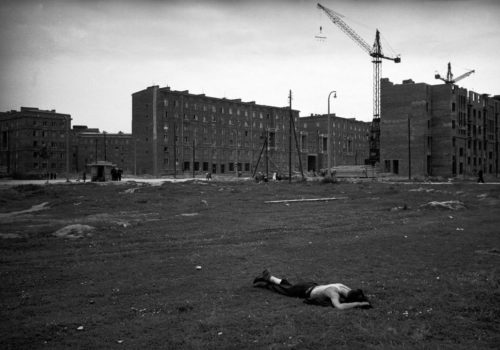Europe was bombed, destroyed, demoralized during World War II, which killed more than 50 million people. Nothing was going to be the same anymore, but Europe’s rebirth from the ravages of war and the furies of Nazism and Fascism was more than just surprising. It was extra-ordinary.
Erich Lessing, was born and raised in Vienna, but he had to leave Austria in 1939 because of the Nazis. He fled to Palestine under British mandate (now Israel), shortly before the war started. His mother stayed in Vienna and died at Auschwitz. While he was in Israel, Lessing studied at Haifa’s technical college; during the war he joined the British Army as a photographer and aviator.
After the war, Lessing moved back to Austria. He began to photograph the European recovery and reconstruction, first for the Associated Press agency and, since 1951, for the Magnum agency, which he joined being invited by David ‘Chim’ Seymour, one of the agency’s founders. Lessing covered political events in North Africa and Europe, and reported on the Communist period in Eastern Europe for major magazines, such as Life, Epoca, Paris-Match. His pictures of the 1956 Hungarian Revolution recorded both the hope and euphoria of the first days of the revolt and the pain of its brutal suppression; for this work he was awarded the American Art Editors´ Award (1956) and the Imre Nagy medal from the President of the Hungary (1992).
Like many of his contemporaries (i.e. Werner Bischof, René Burri, Henri Cartier-Bresson) he was recording, as if it were a mission, the resilience that enabled the Europeans to rebuild their continent and to transform it into a prosperous economy within a few years, despite the fact that it would remain divided into East and West for decades.
The emphasis which characterizes Erich Lessing images dealing with the industrial sector in both Western and Eastern Europe is a unique feature of his work. The photographs by Erich Lessing included in this exhibition (curated by Harry Kalha in partnership with The Finnish Museum of Photography and Laura Serani) are part of the MAST Foundation collection of industrial photography. The present selection in Reggio Emilia recalls the Human Capital in Industry exhibition, which is on stage at the MAST Foundation in Bologna (until August 30th).
In the 1960s, Lessing, who lives in Vienna,turned to more cultural subjects such as art, science, and history. He specialized in large-format color photography, publishing more than forty books and establishing himself worldwide as a photographer of culture. He is a member of UNESCO’s International Commission of Museums, and CIDOC, its information branch. He was assigned several main awards, such as the Prix Nadar for his book Odyssee (1966) or the Grosser Österreichischer Staatspreis (1997)
EXHIBITION
Erich Lessing
Work and Workers after the War
From the MAST Foundation Collection in Bologna
Until July 27th, 2014
Chiostri di San Pietro
Via Emilia San Pietro 44/c
42121 Reggio Emilia
Italy
http://www.fotografiaeuropea.it
















